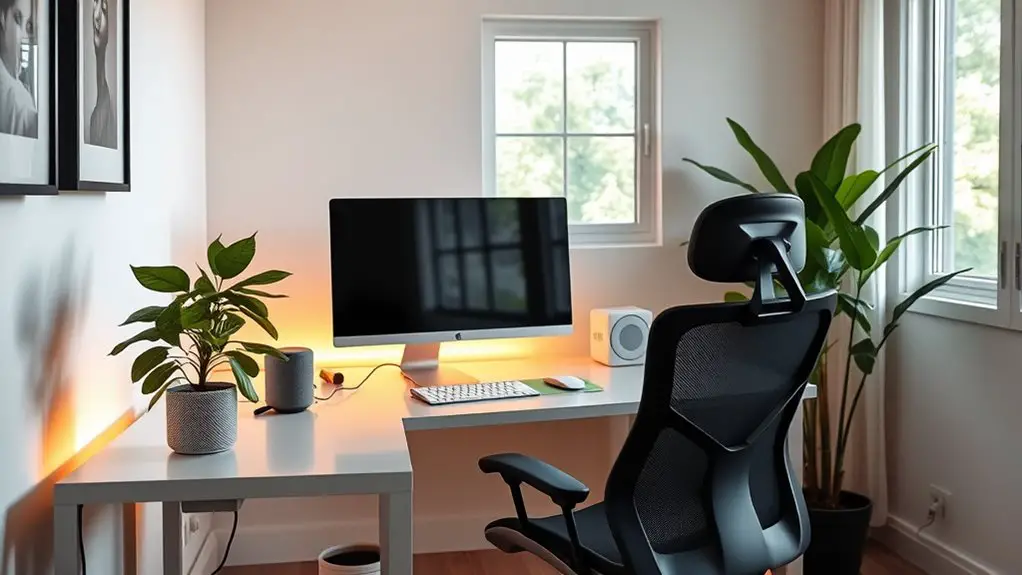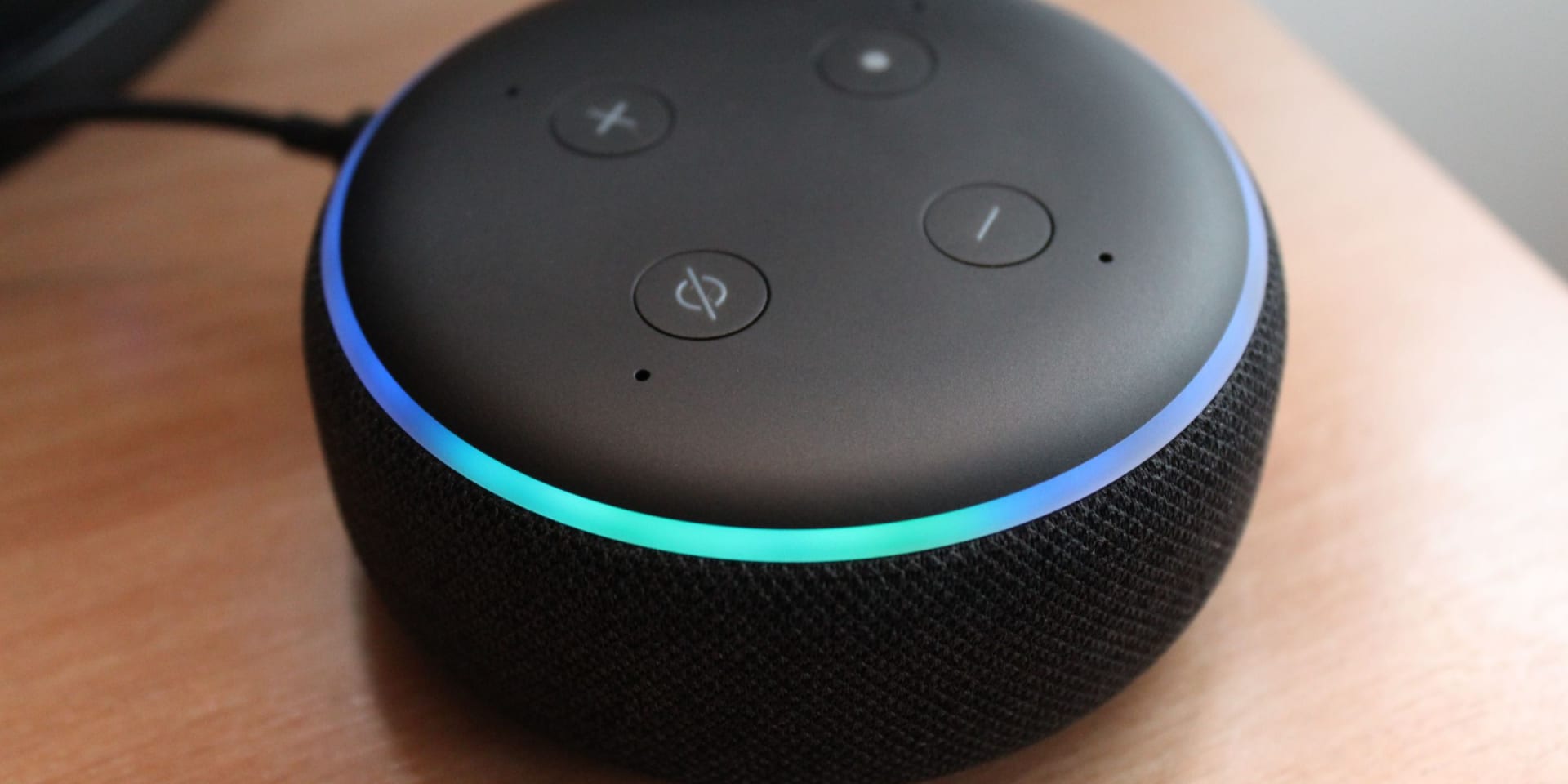To create a smart home office with voice assistants, start by identifying devices like smart speakers, plugs, and lighting. Choose the right voice assistant that fits your ecosystem—options include Google Assistant, Siri, and Alexa. Confirm all devices are compatible and within budget, considering setup costs too. Automate lighting and climate for comfort, and enhance security with smart alarms. If you're curious about the benefits and advanced features, there's plenty more to explore.
Table of Contents
Key Takeaways
- Choose a compatible voice assistant like Google Assistant, Alexa, or Siri to manage your smart office devices effectively.
- Integrate smart speakers, plugs, lighting, and thermostats to streamline control and enhance automation in your workspace.
- Ensure stable network connectivity using Wi-Fi or smart home hubs for seamless device communication and management.
- Automate tasks with voice commands to improve productivity and save time on routine functions in your office.
- Implement strong security measures, like regular updates and encryption, to protect your smart office data and privacy.
Identifying Devices for Automation
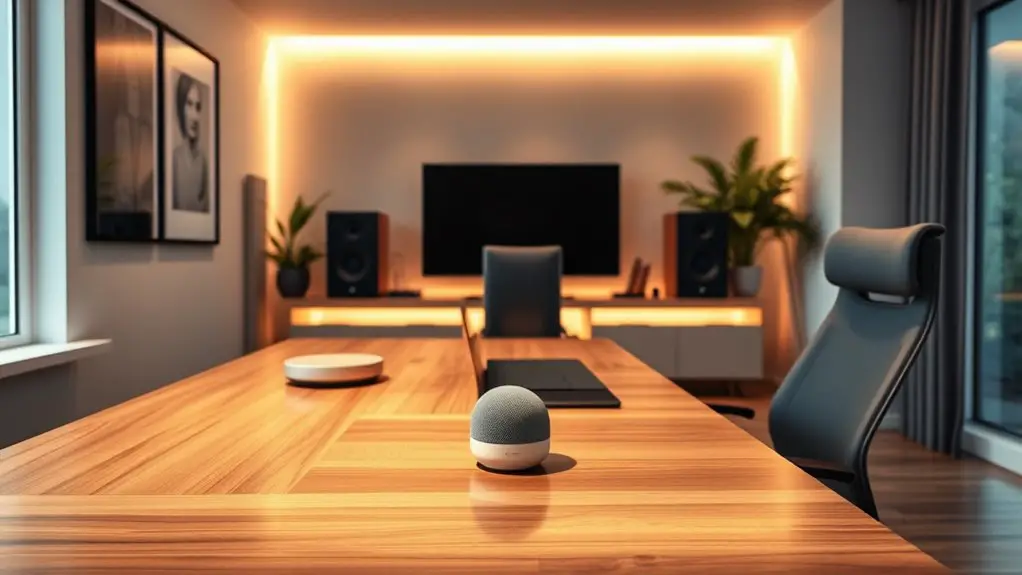
When setting up your smart home office, it's crucial to identify the right devices for automation that enhance your productivity and comfort.
Start with smart speakers, which serve as your control hub, allowing you to issue voice commands effortlessly. Incorporate smart plugs to manage non-smart appliances remotely, optimizing energy use. Additionally, smart speakers can sync with your calendar to keep you organized throughout the day.
Smart speakers act as your control hub, enabling effortless voice commands, while smart plugs optimize energy use for non-smart appliances.
Smart lighting lets you customize brightness and ambiance, crucial for maintaining focus. Smart thermostats automate your environment's temperature for maximum comfort.
Don't overlook motion detection systems that activate lighting as you enter a room, creating a seamless experience.
For added productivity, consider smart earbuds for noise cancellation and automated coffee makers for that perfect brew, keeping you energized throughout your workday.
Selecting the Right Voice Assistant
When selecting the right voice assistant, you need to contemplate compatibility with your devices and the features each assistant offers. Think about whether you're already invested in the Apple, Google, or Amazon ecosystems, as this can make a big difference in functionality. Additionally, evaluate how well each assistant integrates with your smart home devices to enhance your overall productivity. Consider the AI personal assistants available in 2024, as they can significantly boost your efficiency through task management and smart home integration.
Compatibility With Devices
Choosing the right voice assistant for your smart home office hinges on compatibility with your existing devices. Google Assistant works seamlessly with popular smart devices like Nest and Yale, making it a solid choice if you use those brands. Additionally, seamless integration with smart home and security devices enhances the overall user experience, allowing for voice-controlled convenience in managing your office environment.
If you have a mix of Apple and other smart devices, Apple Siri might be your best bet, especially since it integrates well with HomeKit products. Amazon Alexa excels in compatibility with iDevices and is widely embraced in smart setups. Consider local voice assistants like Home Assistant for enhanced privacy and customizability. Don't forget smart hubs like Samsung SmartThings; they can unify your devices, simplifying office management and boosting productivity.
Make sure your chosen voice assistant fits your current technology.
Features and Functionality
Finding the right voice assistant for your smart home office goes beyond just compatibility; it's also about features and functionality that enhance your workflow. Look for voice command capabilities that let you control devices hands-free, boosting your productivity. Task automation features, like setting timers or answering questions, can save you valuable time. If you need quality audio, consider assistants that integrate with smart speakers. Personalization options, such as voice changes, add a unique touch. Additionally, prioritize learning capabilities, like Alexa's Hunches, which predict your needs. With functionalities like calendar management, energy control, and security integration, the right assistant can transform your office into a more efficient workspace tailored to your needs. Voice assistants can also enhance your smart home functionality by controlling devices seamlessly. Choose wisely!
Ensuring Compatibility Among Devices
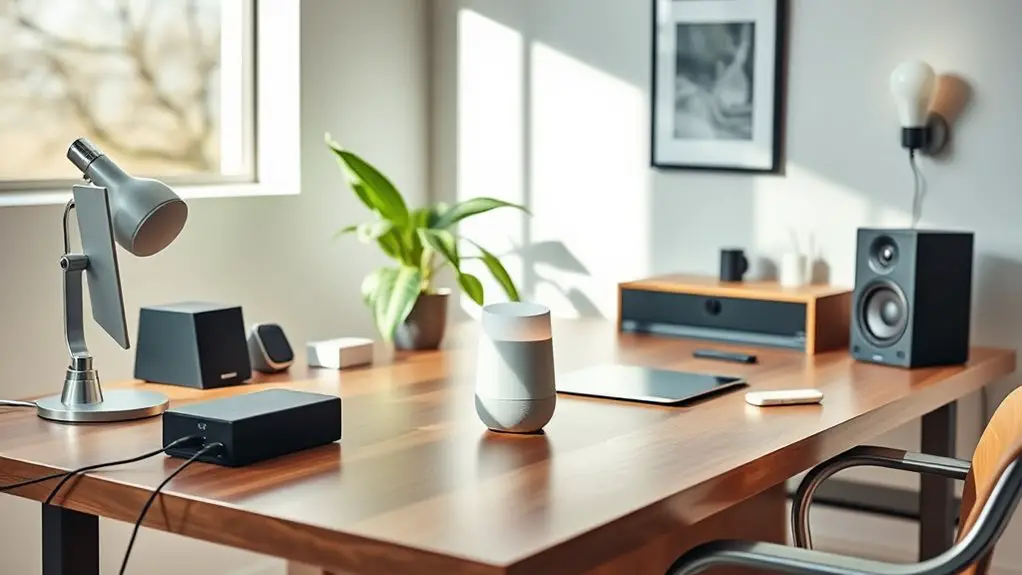
Before you set up your smart home office, check the compatibility of your devices with your chosen voice assistant. Make sure that your smart gadgets work seamlessly within the same ecosystem to avoid frustration later. A quick verification can save you time and enhance your overall experience. Additionally, ensure that your devices can connect with various smart home devices to maximize the functionality of your voice assistant.
Device Ecosystem Check
Ensuring compatibility among devices in your smart home ecosystem is essential for a seamless experience.
Start by choosing a popular platform like Google Home, Amazon Alexa, Apple HomeKit, or SmartThings, each offering unique features and device compatibility. You'll benefit from device integration, allowing various gadgets to work together efficiently. Additionally, selecting the right smart home ecosystem can influence the types of compatible devices available for use.
Make sure your network connectivity is stable, utilizing options like Wi-Fi, Bluetooth, Zigbee, or Z-Wave. If you have devices from different brands, consider a smart home hub like SmartThings to manage them all.
Keep firmware updated to maintain compatibility and resolve any issues. By focusing on these aspects, you'll create a cohesive smart home office environment that enhances efficiency and convenience.
Assistant Compatibility Verification
To create a truly connected smart home office, verifying assistant compatibility across your devices is vital.
Start by checking if your smart devices, like thermostats and security cameras, support major platforms such as Amazon, Google, or Apple. This wide range of integration allows for seamless interaction between your voice assistants and smart hubs. Additionally, investing in a robust hub that supports multiple protocols can significantly enhance interoperability, ensuring better communication between devices.
You should also customize voice commands to enhance functionality and create routines that fit your workflow. Be mindful of common integration challenges, like voice recognition issues and compatibility with older devices.
Utilize manufacturer websites, voice assistant apps, and community forums to troubleshoot any problems. Regularly updating software is essential for maintaining compatibility and ensuring your smart office operates smoothly.
Budgeting for Smart Office Setup
Setting up a smart home office can range from a few hundred to several thousand dollars, depending on the devices and systems you choose. To help manage your budget, consider the following breakdown:
| Category | Estimated Cost | Notes |
|---|---|---|
| Smart Hardware | $100 – $1,500 | Includes lights and assistants |
| Software Licensing | $50 – $500 | Varies based on needs |
| Installation Costs | $0 – $300 | DIY vs. professional help |
| Voice Assistant Setup | $50 – $150 | Integration fees may apply |
| Customization Options | $100 – $1,000 | Tailored to your preferences |
When budgeting for a smart home office, it is essential to consider initial hardware procurement costs, as these can significantly impact your overall setup expenses.
Benefits of Smart Office Automation
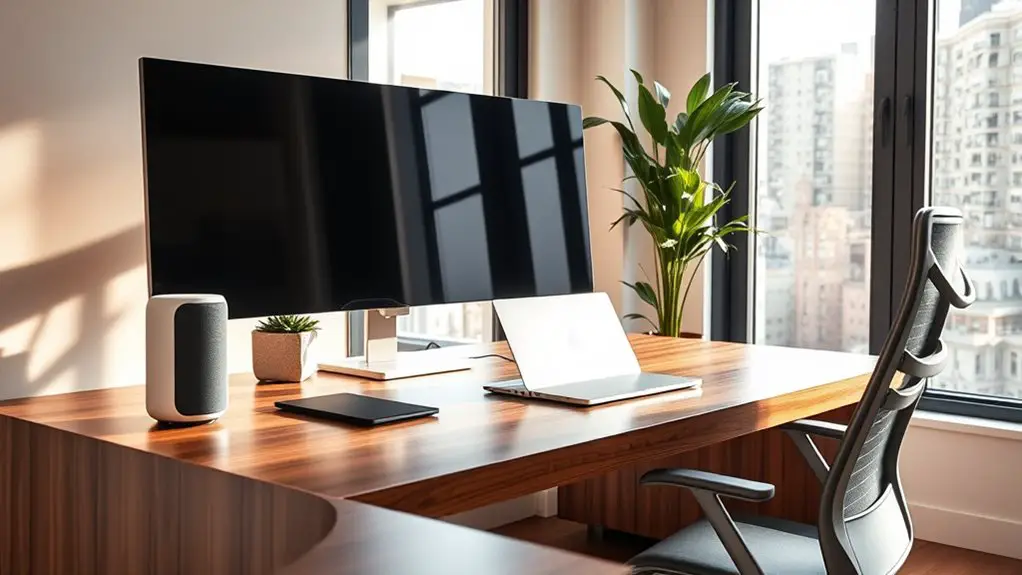
Smart office automation boosts your productivity by streamlining routine tasks, letting you focus on what truly matters. With intelligent systems optimizing energy usage, you'll also save on costs while creating a more efficient workspace. This combination not only enhances your work experience but also contributes to a sustainable environment. Additionally, real-time monitoring of resources such as electricity and water leads to more informed decisions and further cost savings.
Increased Productivity
As automation takes over routine tasks like adjusting lighting and climate control, you can focus more on what truly matters—your high-value work.
By streamlining these tasks, you minimize human error and enhance overall efficiency. The automatic adjustments to temperature and lighting create a comfortable environment that boosts your productivity. Additionally, with smart speakers and displays at your disposal, you can manage your office settings effortlessly through voice commands.
Plus, with real-time data insights from AI, you can make informed decisions quickly. Freeing up your time from repetitive tasks means you can concentrate on strategic and creative projects that drive results.
Embracing smart office automation not only enhances your work experience but also empowers you to achieve your goals more effectively, leading to greater satisfaction and success in your professional life.
Energy Efficiency
Energy efficiency is a game changer for your smart office setup, allowing you to cut costs while minimizing your environmental impact. By integrating smart technologies, you can optimize energy use effectively. Here are some benefits you can enjoy:
- Occupancy Monitoring: IoT sensors detect when spaces are occupied, automating lighting and HVAC systems.
- Automated Systems: Smart automation adjusts lighting and climate based on real-time data, reducing unnecessary usage.
- Smart Lighting: Adjusts brightness and color to match occupancy patterns, cutting down on waste.
- HVAC Controls: Optimizes heating and cooling to save energy while keeping you comfortable. Data-driven insights from occupancy monitoring can further enhance your energy efficiency strategies.
- Cost Savings: Energy-efficient solutions considerably reduce operational costs over time.
Embrace these features to create a sustainable, cost-effective workspace.
Setting Up Google Assistant for Device Control
To effortlessly control your smart home devices with voice commands, you'll need to set up Google Assistant.
Start by downloading the Google Home app on your smartphone. This app helps you link compatible devices, which should have unique names for easy voice recognition. Google Assistant is compatible with over 50,000 smart home devices, so you'll have plenty of options. Ensure your Control4 system has a 4Sight license for optimal integration with Google Assistant.
Download the Google Home app to easily link your smart devices and ensure they have unique names for effective voice control.
Once set up, simply say, "Hey Google," followed by commands like, "Turn on the living room lights." You can organize devices into rooms in the app for efficient management.
If you encounter any issues, the app allows you to resync devices, ensuring smooth operation. Enjoy seamless control of your smart home with voice commands!
Integrating Amazon Alexa With Smart Devices
Integrating Amazon Alexa with your smart devices opens up a world of convenience and control. You can easily manage various aspects of your home office by connecting compatible devices.
Here's what you can take advantage of:
- Over 140,000 devices are compatible, including lights, plugs, and cameras.
- Use "Alexa Built-in" or "Works with Alexa" certified devices for a seamless experience.
- Control devices via voice commands or set up routines for automation.
- Connect through protocols like Wi-Fi, Bluetooth Low-Energy (BLE), Zigbee, and Matter.
- Developers can utilize tools like the Alexa Connect Kit (ACK) to integrate devices.
With Alexa, you can streamline your workspace and enhance productivity effortlessly.
Customizing Voice Commands for Efficiency
Customizing voice commands can take your smart home office experience to the next level. Start by selecting simple phrases that are easy to remember, like "Turn on the office lights."
Customizing voice commands enhances your smart home office, making interactions effortless and intuitive. Start with memorable phrases for ease of use.
You can also create routines that combine multiple actions into one command, making your workflow smoother. Consider crafting unique trigger phrases for these routines, tailoring them to fit your needs. Additionally, ensure that your smart office devices are compatible with the selected voice assistant for seamless integration.
Test your commands to verify they're recognized correctly, and don't hesitate to modify phrases for clarity. Adjust sensitivity settings to improve recognition and troubleshoot any issues as they arise.
Finally, explore pre-set commands available in your assistant's app to enhance functionality without starting from scratch. This way, you'll maximize efficiency in your smart workspace.
Automating Lighting and Climate Control
While you work in your smart home office, automating lighting and climate control can greatly enhance your productivity and comfort.
By integrating smart lighting and climate control systems with voice assistants, you can create a more efficient workspace. Here are some key benefits:
- Adjust brightness and color to mimic natural daylight, boosting your focus.
- Control settings hands-free with simple voice commands for ultimate convenience.
- Set personalized scenes for different tasks or moods, enhancing your experience. In addition, implementing human-centric lighting can further promote alertness and productivity during work hours.
- Optimize energy use with smart thermostats that learn your patterns.
- Utilize occupancy sensors to automatically manage lighting based on room presence.
Implementing these features can transform your workspace into a more comfortable and productive environment.
Enhancing Security With Smart Devices
A well-designed smart home office not only boosts productivity but also enhances your security. Start by installing smart cameras with motion detection to monitor for potential intruders. Use door and window sensors to alert you of unauthorized access, while indoor motion sensors add another layer of protection. Integrate these devices with your voice assistant for easy monitoring and control. Centralize management through IoT connectivity to guarantee real-time updates. Implement smart alarm systems that can be activated by voice commands. Additionally, consider incorporating advanced security solutions that utilize intelligent automation for tasks like access control and surveillance. Don't forget about data security: secure your Wi-Fi, use multi-factor authentication, and keep your devices updated. Regularly monitor device activity logs, and configure privacy settings to safeguard your information. Enjoy peace of mind in your smart workspace!
Streamlining Marketing With Voice Technology
Voice technology is revolutionizing marketing strategies, making interactions more efficient and engaging. By adopting voice assistants, you can enhance your marketing efforts and connect better with your audience.
Voice technology transforms marketing, fostering more engaging and efficient interactions with your audience through innovative voice assistants.
Here are some key benefits:
- Voice-Activated Ads: Engage users through spoken commands.
- AI-Driven Personalization: Tailor experiences based on user data.
- Interactive Campaigns: Allow customers to interact with branded voice personas.
- Integration Across Channels: Utilize smart speakers, smartphones, and even vehicles for marketing.
- Market Growth: Audio ad spending is projected to reach $40.38 billion by 2024. Furthermore, voice ads drive higher engagement and recall rates due to their conversational nature.
Embrace these innovations to streamline your marketing and create memorable experiences for your customers.
Don't miss out on this opportunity to elevate your brand engagement!
Frequently Asked Questions
Can I Use Multiple Voice Assistants in One Office?
Yes, you can use multiple voice assistants in one office. Just assign specific tasks to each, use different wake words, and document which assistant controls which devices to avoid confusion and enhance efficiency.
How Do I Troubleshoot Connectivity Issues With Smart Devices?
To troubleshoot connectivity issues with smart devices, restart your router and devices, check for interference, guarantee proper positioning, update software, and verify that everything's linked correctly. Don't forget to check for any outages, too.
Are Smart Devices Energy-Efficient Compared to Traditional Ones?
Yes, smart devices are generally more energy-efficient than traditional ones. They optimize energy usage, reduce consumption considerably, and often save you money in the long run, making them a smart choice for your home.
What Happens if My Internet Goes Down?
If your internet goes down, most smart home devices won't function properly. You'll need manual overrides or backup systems to regain control. Some local devices might still work, but overall functionality will be limited.
Can I Control Smart Devices Remotely When I'm Away?
Yes, you can control smart devices remotely when you're away. Just guarantee your devices are connected to a stable Wi-Fi network and you've got the necessary apps or voice assistants set up for remote access.
